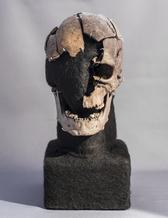Researchers have mapped the life of a Stone Age man in detail. New scientific methods have revolutionised archaeology and the Swedish-Danish team of researchers at the University of Gothenburg are now able to state that "Vittrup Man", a Stone Age man found in a bog in Denmark, travelled across a wide geographical area during his lifetime.
Vittrup Man was first discovered in 1915. His skull had been split by at least eight blows from a club and his body placed in a wetland in north Jutland. Until recently, this was all we knew about him. Researchers now know that he had travelled a long way before his death in about 3200 BCE. He must have led an interesting life.
"He comes from the north, from a relatively cold area, and it must have been a coastal area because the food he ate as a child came from the sea," says archaeologist Karl-Göran Sjögren, a member of the research team.
Ate a lot of fish as a child
The team thinks the man grew up in what is now northern Norway. But when he was about 18 or 19, he ended up in Denmark for some reason. There, his diet changed from fish from the sea to food produced by agriculture.
"He then spent ten to twenty years living in a farming community in Denmark before he died. Actually, he was brutally clubbed to death," says Karl-Göran Sjögren.
The University of Gothenburg conducts world-leading archaeological research in which new scientific methods play a central role. DNA analysis, analysis of dental calculus and isotope analysis are enabling researchers to discover completely new information.
The researchers analysed tartar from the man to see, what he ate. They also measured different isotopes in his teeth and skull to map his travels and his changes in diet.
"This enabled us to follow this individual's geographical and dietary development from birth to death. As far as we know, this is the first time researchers have been able to map a person's life history in such great detail and from so long ago," says archaeologist Anders Fischer, part of the Swedish-Danish team, who is linked to the University of Gothenburg.
Teeth and bone fragments provide clues

The study has been published in PLOS ONE and is part of a largerstudy recently published in the journal Nature, in which researchers examined the genomes and DNA of the prehistoric Nordic population. The study in Nature was based on analysis of DNA and dietary markers from 100 teeth and bone remains found in Denmark. Vittrup Man is one of these 100 people.
Anders Fischer explains why the archaeologists chose to take a closer look at this particular man's life.
"His genome differed markedly from the rest of the Danish Stone Age population, and genetically, he was closely related to contemporary people living on the Scandinavian peninsula, in what is now northern Norway and Sweden. This is why we chose to study his origins and life history in detail."
The researchers analysed oxygen and strontium isotopes from the man's teeth. Strontium is an element found in food and water which is absorbed by the teeth during childhood. Using this method, researchers were able to see that the strontium in the Vittrup Man does not come from the geographical area where he was found dead in a bog.
But the questions of how he ended up in Denmark or why he was clubbed to death still remain unanswered. Here, the archaeologists can only speculate. In the Stone Age, travelling from what is now northern Norway to Denmark must have been a long and arduous journey. His subsequent brutal death might indicate that he was sacrificed, according to the researchers.
Stone Age man could have been sacrificed
"Vittrup Man is an example of a ritual practice that was common in this period. The murder weapon may be the wooden club found with him when peat cutters found his skeleton in Vittrup in northern Jutland more than a hundred years ago," says professor of archaeology Kristian Kristiansen, head of the Rise II project.

Lasse Sørensen is an expert in the Neolithic period at the National Museum of Denmark in Copenhagen and a member of the research team. He explains that there is already archaeological evidence of contacts between Denmark and northern Norway during the Stone Age. Archaeologists have long known that flint axes were transported in this period; from Denmark all the way up to the Arctic Circle in Norway.
"The study now adds a real flesh and blood human being to these finds," says Lasse Sørensen.
The study and the Swedish-Danish research team are headed by the University of Gothenburg and are part of the Rise II research project. The study Vittrup Man - the life-history of a genetic foreigner in Neolithic Denmark, has been published in the scientific journal PLOS ONE.
https://journals.plos.org/plosone/article?id=10.1371/journal.pone.0297032






